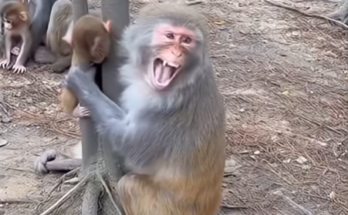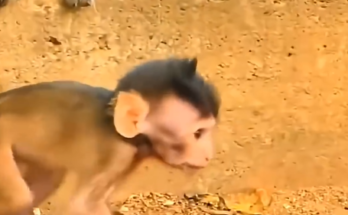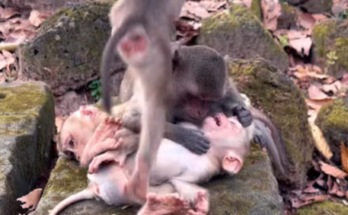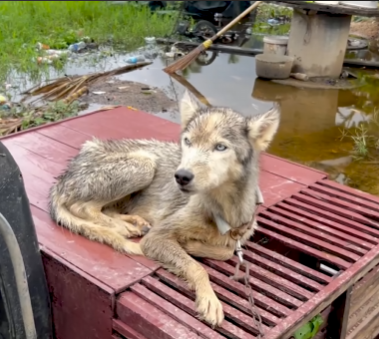
The rain had been falling for three days straight. The river that usually curved gently behind the village had turned into a roaring monster — swallowing everything in its path. Roads disappeared under brown, swirling water; homes were half-submerged; animals clung to whatever they could to stay alive.
We were part of a small rescue team, moving slowly through what used to be a street, our boat pushing against the debris floating everywhere — furniture, tree branches, even broken rooftops. Every sound was muffled by the endless roar of rain and the cries of animals trapped by the flood.
I remember the moment we saw him.
At first, it was just a flash of gray and white against the muddy backdrop — something moving on a chain attached to a wooden post that barely stood above the waterline. Then, as the boat drifted closer, I realized it wasn’t just something. It was someone.
A husky.
He was standing on his hind legs, front paws hooked desperately on the post, the chain around his neck pulled so tight that it looked like it might snap — or strangle him. The water reached up to his chest, rising inch by inch. His fur was soaked, his eyes wild with fear.
“Oh my God,” I whispered. “He’s chained there.”
The boat’s engine sputtered as we approached. He started barking — not angrily, but in panic, as if begging us to hurry. The sound of his voice carried through the rain, raw and desperate.
“Hang on, boy!” I shouted. “We’re coming!”
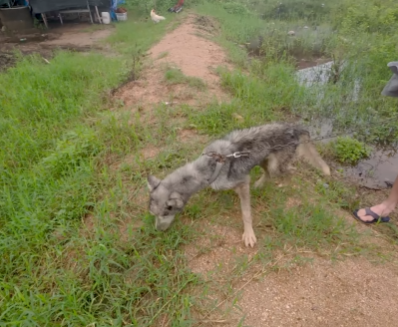
The closer we got, the clearer the situation became. Whoever had left him there had chained him to a post outside a collapsed shack, maybe to keep him from running away. But now, with the flood swallowing everything, that same chain had turned into his prison — and it was killing him.
He tried to climb the post again, claws scraping against wet wood, but his strength was fading. Every time he slipped, the chain jerked and the water splashed higher. He was trembling — from exhaustion, from fear, from cold.
I could see the whites of his eyes now, the terror written all over his face. He wasn’t fighting anymore to escape. He was fighting to breathe.
“Cut the engine!” I yelled to my partner, and we coasted in closer. The current was strong, pushing against the boat. We had to anchor it to a nearby tree stump just to keep from being swept away.
I grabbed my rope and a pair of bolt cutters and jumped into the knee-deep water. The cold hit me like a punch, but I didn’t care. The husky saw me and started whining — low, trembling sounds that broke my heart.
“It’s okay, boy,” I said softly, inching closer. “We’re here. You’re going to be okay.”
He didn’t believe me at first. His body pressed against the post, eyes darting, chain rattling. Every instinct told him not to trust humans — not after being abandoned like this. But when I reached out and put my hand on his neck, he froze.
I could feel his pulse — rapid, frantic, but alive.
The chain was thick and rusted, the metal biting into his soaked fur. It took everything I had to get the bolt cutters in position. My hands slipped twice, the tool nearly falling into the water. Finally, with one hard squeeze, the metal snapped.
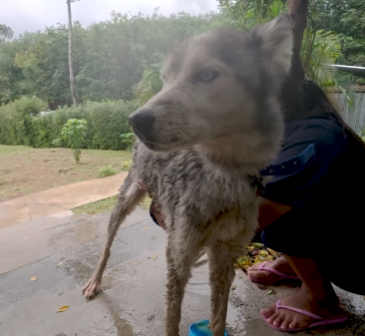
The moment it did, he stumbled forward — straight into my arms.
He didn’t run. He didn’t bark. He just collapsed against me, shaking violently. His body was ice-cold. I wrapped my arms around him, whispering, “You’re safe now. You’re safe.”
We pulled him onto the boat. He lay there, silent, shivering uncontrollably. His eyes darted between us, confused, terrified, but slowly — just slowly — the panic began to fade.
As we turned the boat around, I looked back at the house where he’d been tied. The water was already rising above the post. If we’d come even half an hour later, he would’ve been gone.
Back at the shelter, we worked fast to warm him up. We dried his fur with towels, wrapped him in blankets, and gave him water. But even after hours, he still wouldn’t eat. He just lay curled up in the corner, his head resting on his paws, his eyes staring at nothing.
He had scars around his neck — deep grooves where the chain had rubbed for years. His fur was thin in patches, and his body was far too light for a husky his size. Whoever had owned him had cared only enough to keep him alive — but not enough to love him.
We named him Storm.
It fit — not just because we’d found him in the middle of one, but because he had survived one inside himself, too.
The first few days were quiet. He barely moved. When someone approached too fast, he flinched and pressed himself into the wall. But whenever Lila — one of our most patient volunteers — sat near him, he’d lift his head just slightly. She never touched him without asking first. She’d just sit, cross-legged, and talk in a calm, soothing voice.
“You’re safe now, Storm,” she’d whisper. “No more chains. No more floods.”
By the end of the week, he was eating again.
The first time he wagged his tail — just once, timidly — the entire team cheered. It wasn’t much, but it was everything.
Weeks passed.
Storm began to walk outside again, slowly, sniffing the grass, feeling the sunlight on his face. He was still wary — loud noises made him jump, and sudden movements sent him hiding — but he was learning that not every hand meant harm.
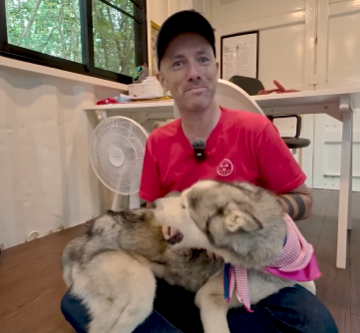
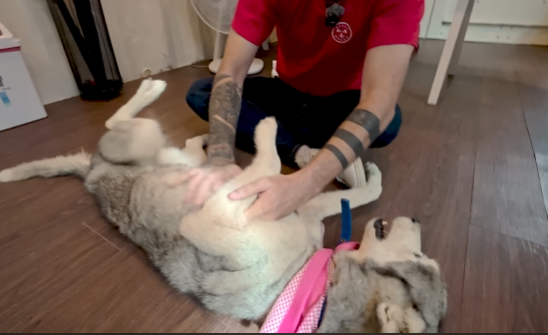
The day he discovered the open field behind the shelter, something in him changed. He stood there, breathing deeply, the wind ruffling his fur. Then, out of nowhere, he started to run.
It wasn’t graceful — his legs were still weak, his movements awkward — but it was freedom. Pure, unfiltered freedom. He ran in circles, barking once, twice, louder each time, as if rediscovering his voice.
We stood watching, tears in our eyes.
For a dog that had once stood chained above deadly floodwater, every step was a miracle.
Months later, Storm was adopted by a family who lived on a small farm in the hills — far from the city, far from fear. They sent us pictures every week. In one, Storm was lying under a tree, a child’s hand resting on his head. In another, he was running through the field with a bright red ball in his mouth.
His eyes looked different now — softer, brighter, alive.
The scars around his neck were still there, faint reminders of the life he’d escaped, but they no longer defined him. What defined him now was love — the kind that heals without words, the kind that replaces pain with peace.
Lila cried when she saw the photos. “He finally got his second chance,” she said quietly.
And she was right.
Whenever it rains now, I think of him. I think of that moment — a frightened husky standing against the flood, chained and forgotten, refusing to give up even when the world turned against him.
He fought until help arrived.
He fought until love reached him.
And because of that fight, because of that stubborn spark of life that refused to fade, Storm’s story became more than just another rescue tale. It became proof — that even when the water rises, even when hope seems lost, there’s still a reason to hold on.
For some, survival is just breathing.
For Storm, it was waiting — waiting for the day someone would finally see him, break the chain, and whisper the words that changed everything:
“You’re safe now.”
